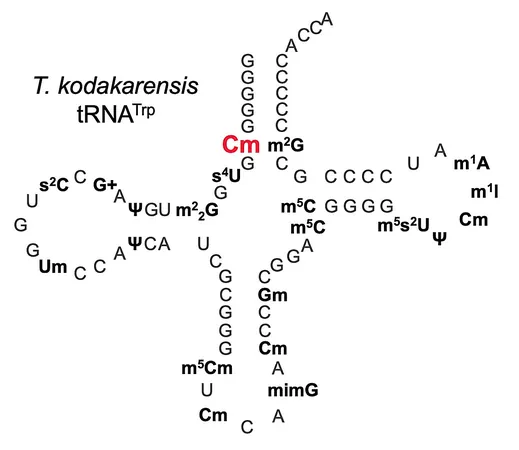
Groundbreaking Discovery: A Unique tRNA Methyltransferase That Could Reshape Our Understanding of Life's Resilience
2025-07-18
Author: Jia
Unlocking the Secrets of Life's Building Blocks
All living organisms encode proteins through intricate systems that translate genetic information stored in DNA. This process involves a crucial player: transfer RNA (tRNA), which acts as the bridge linking the genetic code with the creation of functional proteins.
The Unsung Hero: tRNA's Role in Protein Synthesis
tRNA decodes the mRNA's codons, delivering the necessary amino acids to the ribosome—the powerhouse of protein synthesis. But the journey doesn’t stop there; once synthesized, tRNAs undergo a series of chemical modifications that enhance their stability and functionality.
Surviving Harsh Environments: The Evolution of Archaeal tRNA
Among Earth's ancient life forms, archaea stand out for their ability to thrive in extreme environments, from boiling hot springs to highly saline lakes. The unique modifications of archaeal tRNAs have evolved over time, contributing to their ability to withstand these harsh conditions.
A Major Breakthrough in tRNA Research
In a groundbreaking study published in Nucleic Acids Research, researchers turned their attention to the tRNA from Thermococcus kodakarensis, a heat-loving archaeon. A key modification, known as 2′-O-methylcytidine (Cm) at position 6, was identified, but the enzyme responsible had remained a mystery—until now.
Discovery of the Mysterious Enzyme: Meet TrmTS
Using comparative genomics, the team targeted the TK1257 gene in T. kodakarensis, leading to a remarkable discovery. The enzyme produced by TK1257 is now identified as a previously uncharacterized tRNA methyltransferase, aptly named TrmTS.
A Structural Marvel: The Architecture of TrmTS
What sets TrmTS apart? Its unique structure features both THUMP and SPOUT domains, an unprecedented combination in the world of tRNA methyltransferases. This design allows TrmTS to specifically modify nucleotides adenosine, cytidine, and uridine—never touching guanosine, providing a unique substrate selectivity profile.
Survival of the Fittest: The Role of Cm6 in Heat Resistance
Further experiments revealed that a mutant of T. kodakarensis, lacking the trmTS gene, suffered impaired growth at extreme temperatures of 93°C. This suggests that the Cm6 modification is vital for tRNA thermal stability, showcasing the adaptability of archaea in extreme environments.
A Paradigm Shift in Our Understanding of tRNA Modification
The discovery of TrmTS revolutionizes our understanding of tRNA biology, challenging existing classifications and emphasizing the diversity of tRNA modifications. These insights not only illuminate the evolutionary journey of tRNA in archaea but also offer a deeper understanding of molecular strategies that allow life to endure in some of Earth’s most inhospitable areas.





 Brasil (PT)
Brasil (PT)
 Canada (EN)
Canada (EN)
 Chile (ES)
Chile (ES)
 Česko (CS)
Česko (CS)
 대한민국 (KO)
대한민국 (KO)
 España (ES)
España (ES)
 France (FR)
France (FR)
 Hong Kong (EN)
Hong Kong (EN)
 Italia (IT)
Italia (IT)
 日本 (JA)
日本 (JA)
 Magyarország (HU)
Magyarország (HU)
 Norge (NO)
Norge (NO)
 Polska (PL)
Polska (PL)
 Schweiz (DE)
Schweiz (DE)
 Singapore (EN)
Singapore (EN)
 Sverige (SV)
Sverige (SV)
 Suomi (FI)
Suomi (FI)
 Türkiye (TR)
Türkiye (TR)
 الإمارات العربية المتحدة (AR)
الإمارات العربية المتحدة (AR)